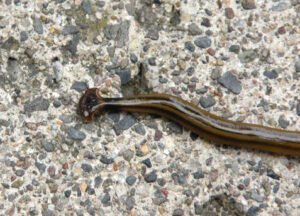
You might be wondering, “What the heck is a hammerhead worm?” Well, think of these worms as the uninvited guests at your gardening party. They come in looking a bit like a slimy, squished pancake with a flat head that resembles a hammer—hence their rather dramatic name. In this guide, we’ll walk through the signs that your garden might be dealing with these unwanted invaders and what you can do about it.
What Are Hammerhead Worms?
Hammerhead worms are members of the *Bipalium* genus and are known for their distinctive hammer-shaped heads. Typically, these worms can grow quite long—some even reaching up to 12 inches! They thrive in warm, humid environments and are often seen in gardens, especially in tropical or subtropical areas. While they may look harmless, they’re actually predatory worms, feeding primarily on earthworms.
Here’s something alarming: if you spot one hammerhead worm, there’s a good chance there are more lurking nearby. They reproduce through fragmentation, meaning one can quickly turn into many! So, it’s essential to recognize the signs early on.
Signs of a Hammerhead Worm Infestation
Identifying a hammerhead worm infestation can save your garden from significant damage. Here are several signs to watch out for:
Physical Sightings
The most obvious sign is spotting a hammerhead worm itself. These worms can vary in color but are typically brown or gray with a distinctive head—flattened and wider than the rest of their bodies. If you see them slithering around your garden beds, it’s time to take action.
Unusual Soil Disturbances
Another sign to look for is unusual disturbances in the soil. Hammerhead worms can disrupt the soil as they navigate through it. If you notice unusual burrow patterns or soil that seems unusually loose or disturbed, those could be signs of these invaders at work.
Declining Plant Health
Hammerhead worms are known for their diet of other worms, particularly earthworms, which are essential for healthy soil. If your garden’s health is declining—plants looking wilted or stunted—this might be a sign of an infestation. Healthy earthworm populations maintain nutrient-rich soil, so a reduction can lead to unhealthy plants.
How to Confirm the Infestation
So, how can you confirm that those slimy guests are indeed hammerhead worms? A little investigation can help!
Checking the Soil
To confirm their presence, dig a little. Look for those telltale signs of soil disturbance, but you might also find actual worms. Use a trowel to carefully sift through the soil and see if you can locate any hammerhead worms.
Using Bait
You might also want to try baiting. Set out some decaying organic matter, like fruit scraps, in small containers around the garden. If you find a few hammerhead worms feasting, it’s a pretty clear indication they’re around and causing problems.
Observing Other Wildlife
If you notice fewer birds, toads, or other wildlife in your garden, this may indicate an imbalance in the ecosystem. Since hammerhead worms feast on earthworms, a decline in earthworms can deter these beneficial creatures, indicating an infestation.
Why Hammerhead Worms Are a Problem
You might be thinking, “Okay, they’re gross—but why are they such a big deal?” Well, let’s dive into that.
Impact on Soil Health
Hammerhead worms can significantly affect soil health. They prey on earthworms, which play a critical role in aerating the soil and enriching it with nutrients. Without healthy earthworm populations, your soil may become compacted, leading to poor plant growth.
Damage to Plants
In addition to harming the soil, these worms can indirectly cause harm to your plants. Reduced earthworm activity means less nutrient availability, which can lead to yellowing leaves, stunted growth, and ultimately, plant death.
Rapid Reproduction
Here’s the kicker: hammerhead worms reproduce rapidly. A single worm can break apart to form new individuals, making it tough to control an infestation. If you don’t tackle this issue early, it can spiral out of control, leading to a full-blown infestation in no time.
How to Get Rid of Hammerhead Worms
If you’ve identified hammerhead worms in your garden, don’t panic! There are ways to manage their population and minimize their impact.
Manual Removal
One effective method is manual removal. Gloves on, pick up the worms you encounter. Drop them into a bucket of soapy water to eliminate them humanely. Sounds a bit gross but think of it as gardening maintenance!
Creating a Barrier
You can also create barriers. Mulching with organic materials like wood chips may make your garden less appealing to these worms. They prefer moist conditions, so reducing moisture can also help deter them.
Using Natural Predators
Consider introducing natural predators like certain birds or toads that enjoy munching on these worms. This could help tip the balance back in favor of a healthy ecosystem.
Preventing Future Infestations
After dealing with an infestation, it’s crucial to think long-term to prevent future issues.
Encouraging Earthworms
To keep your garden healthy, encourage earthworm populations by adding organic matter like compost or leaf mold. This not only improves soil quality but also provides food for your beneficial earthworms.
Maintaining Soil Health
Regularly check and maintain your soil health. Test pH levels, manage moisture, and ensure your soil has the right nutrients. A robust ecosystem is less likely to suffer from invasions.
Regular Monitoring
Lastly, keep a close eye on your garden. Regular monitoring will help you catch any problems early before they escalate. Set aside even a few minutes each week to look for any suspicious signs, so you can act quickly.
Recognizing the signs of a hammerhead worm infestation early can save your garden from severe damage. From observing the physical signs to monitoring soil health, staying proactive is key. Remember, a thriving garden is all about balance, and while hammerhead worms may not be the best house guests, with the right care and attention, you can keep them at bay and ensure your plants flourish. Happy gardening!
